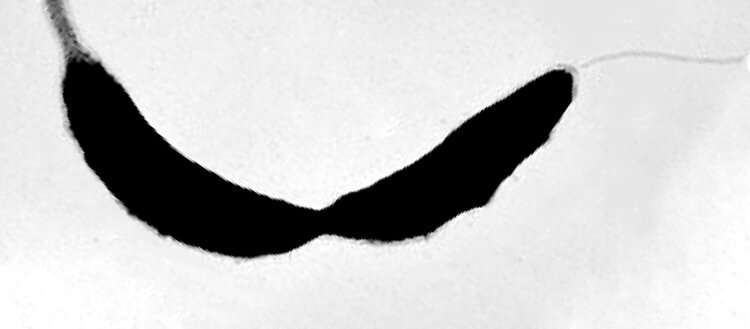The sweet spot of flagellar assembly

To build the machinery that enables bacteria to swim, over 50 proteins have to be assembled according to a logical and well-defined order to form the flagellum, the cellular equivalent of an offshore engine of a boat. To be functional, the flagellum is assembled piece by piece, ending with the helix called flagellar filament, composed of six different subunits called flagellins. Microbiologists from the University of Geneva (UNIGE) have demonstrated that adding sugar to the flagellins is crucial for the flagellum's assembly and functionality. This glycosylation is carried out by a newly discovered enzyme FlmG, whose role was hitherto unknown. Based on this observation—which you can read all about in the journal eLife—the researchers followed up with a second discovery published in Developmental Cell. Among the six flagellins of Caulobacter crescentus, the model bacterium in the two studies, one is the special one serving a signaling role to trigger the final assembly of the flagellum.
The flagellum is the locomotive engine of bacteria. Thanks to the flagellum, bacteria can swim towards food whether in lake Geneva (Léman) or inside the host during an infection. The flagellum—which, due to its complexity, is similar to an offshore engine—is made up of a basic structure, a rotary motor and a helical propeller. It is synthesized inside the bacteria in their cytosol. "The 50 proteins must be produced sequentially and assembled in the right order," begins Patrick Viollier, a researcher in UNIGE's Department of Microbiology and Molecular Medicine. At the same time the flagellum must be embedded within the bacterial envelope that contains up to three cell layers before ending up on the outside. While the flagellar subunits are known many of the subtleties in flagellar assembly control and targeting mechanisms are still poorly understood.
Sweet suprise
The UNIGE microbiologists studied the bacterium Caulobacter crescentus. "These bacteria are very interesting for studying flagella since they produce two different daughter cells: one has a flagellum and the other doesn't. They're ideal for understanding what is needed for building a flagellum ", explains Nicolas Kint, co-author of the study. Another peculiarity is that the flagellar filament of this bacterium is an assembly consisting of six flagellin sub-units, meaning it isn't the result of the polymerisation of a single protein, as is the case for many other bacteria. "When analyzing these six flagellins, we discovered they were decorated with sugars, indicating that a glycosylation step—an enzymatic reaction adding sugars to proteins—was taking place and was needed for assembly. It was a surprising discovery, since this reaction is not very common and not well understood in bacteria," continues Professor Viollier.
Viollier's research team succeeded in demonstrating that the glycosylation of the six flagellins that make up the filament is essential for the formation and functionality of the flagellum. "To demonstrate this, we first identified the gene that produces the glycosylation enzyme, FlmG. When it's absent, it results in bacteria without flagellum. Secondly, we genetically modified another type of bacterium, Escherichia coli, to express one of the six flagellins, the glycosylation enzyme and sugar producing enzymes from Caulobacter crescentus. All these elements are required to obtain a modified flagellin," adds Nicolas Kint.
A versatile black sheep
"The different elements of the flagellum are produced one after the other: the molecules of the base first, then those of the rotor and finally the propeller. The scientific literature indicates that this sequential process is important. However, we don't know how the order of manufacturing the sub-units is controlled ." The researcher and his team focused on the synthesis of the six flagellins, discovering a black sheep among them: a sub-unit that has only 50% sequence homology with the other five. "This sub-unit serves as become a checkpoint protein, a repressive molecular traffic cop restraining the synthesis of the other flagellin proteins," says Professor Viollier. It is present before the synthesis of the other five sub-units, and it acts as a negative regulator. As long as it is present in the cytosol, the synthesis of the other sub-units is prevented. Once the elements of the flagellum are assembled, apart from the filament, the cop is exported to the membrane and thus removed. Then the synthesis of the last five sub-units can then begin. "It is a sensor for the protein synthesis and a component of the flagellar filament at the same time: a dual function that is unique of its kind," says the microbiologist with great enthusiasm.
This discovery is fundamental for understanding the motility of bacteria and the assembly of proteins. "It also provides clues for understanding the synthesis and assembly of tubulin, an essential part of the cytoskeleton," concludes Professor Viollier.
More information: Silvia Ardissone et al, Secretion Relieves Translational Co-repression by a Specialized Flagellin Paralog, Developmental Cell (2020). DOI: 10.1016/j.devcel.2020.10.005
Journal information: eLife , Developmental Cell
Provided by University of Geneva





















